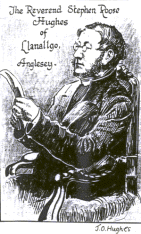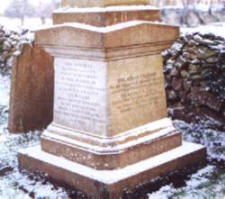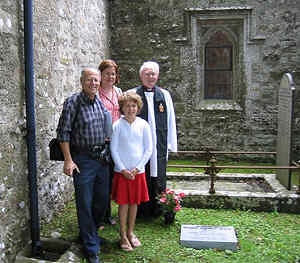The Wreck of the Royal Charter
For Information or lectures Contact Mr. Peter Day Tel: 01248 853444
St. Gallgo’s Church will be forever associated with the wreck of the Royal Charter
“On the 26th of August, 1859, the “Royal Charter” steamship, registered 2,719 tons burthen, furnished with auxiliary engines of 200 horse-power, steamed out of Hobson’s Bay, Victoria, bound for Liverpool. She was equipped with her full complement of officers and crew, commanded by Captain Taylor, who had gained golden opinion, by his previous rapid and successful voyage, having accomplished the passage from Liverpool to Melbourne in fifty-nine days; and who now, in charge of 400 passengers, and a consignment of gold valued at half-a-million sterling, proudly looked forward to completing his triumph by landing his precious freight of life and property in Liverpool, within the same period which had been occupied in his transit from that port to Melbourne” (Wreck of the “Royal Charter” Steam Clipper, by A.& J.K, Dublin 1860).
A fast passage was accomplished around Cape Horn where an iceberg approached rather close to the clipper but the passengers were more than satisfied with the passage and expressed it in a “testimonial to Captain Taylor on the 24th of October, when the Royal Charter lay at anchor about twenty miles off the Cove of Cork. We need scarcely observe that all on board the Royal Charter were animated by the hope of arriving safe at Liverpool, from the circumstances of not a breath disturbing the water when she steamed off the shores of Ireland”. Night approached. “The wind, which had been freshening in the earlier part of the day, now burst with uncontrollable fury over the devoted ship. The captain signalled for a pilot off the Skerries, and also when off Point Lynas, but was forced to proceed without one; for no pilot-boat dare venture amid the breakers in the darkness of that terrible night”.
It was now eleven o’clock, p.m., and the vessel was becoming unmanageable. The captain made an attempt to stay the ship, by bracing the yeards the other way and squaring them, but she resisted all efforts. The port anchor was let go, and one hundred fathoms of chain cable paid out. Shortly after, the starboard anchor was let go, and seventy fathom of chain; these succeeded in checking the vessel until 1.30, a.m., when the port chain parted; but while this was doing the starboard cable also parted, and immediately after the vessel grounded”.
At day break, about 5.30 a.m., the wreck was seen from the shore by Thomas Hughes and Mesech Williams who could do nothing but stand and watch the tempestuous sea and the helpless wreck. “Every moment the horrified spectators expected to see the waves burying in their depths the wrecking vessel, and more intense became their terror and excitement, when they beheld a man let himself down from the decks by a rope into the midst of the breakers”
“This was the heroic Joseph Rogers (a Maltese able seaman), who volunteered to swim with a hawser to shore, and who, though three times driven back by the hissing floods, nobly persevered, and succeeded in making fast the rope to the rock – now the only means that remained of landing those on board the Royal Charter”.
Through the efforts of Rogers and the men of Moelfre, who formed a human chain into the raging seas, 18 of some 376 passengers, 5 of 11 riggers working their passage, 18 of more than 100 crew – no officers, were saved. The names of the 28 local men are not to be found on any monument and they are recorded here with pride:
The Moelfre Twenty Eight
Thomas Roberts |
Owen Roberts |
Owen Roberts jr. |
David Williams |
Mesech Williams |
Robert Lewis |
Thomas Hughes |
John Hughes |
William Owen |
Richard Hughes |
Evan Williams |
John Parry |
John Owens |
Thomas Parry |
John Lewis |
Joseph Williams |
Thomas Owen |
William Williams |
Richard Mathew |
Israel Mathew |
William Pritchard |
Owen Hughes |
Richard Evans |
David Owen |
John Lewis jr |
William Owen |
Lewis Francis |
John Francis |
Some there by who have left behind them a name to be commemorated in story. Others are unremembered, they are perished as though they had never existed.
Ecclesiasticus 43 v. 8 and 9
This list, together with a graphic account of the disaster and its aftermath, is told in The Golden Wreck The Tragedy of the ‘Royal Charter’ Alexander McKee, 0-450-41906-1). A contemporary account by Charles Dickens is found in his Uncommercial Traveller. This account has been reprinted in Shipwreck: Charles Dickens and the Royal Charter, edited by Robert Williams 1-872778-03-6
 The Rector of Llaneugrad and Llanallgo at the time is immortralised by
Charles Dickens in The Uncommercial Traveller. He was the Reverend
Stephen Roose Hughes whose brother, the Reverend Hugh Robert Hughes,
previously a curate in Llanallgo, was the Rector of Penrhosllugwy. He,
too, is mentioned by Charles Dickens.
The Rector of Llaneugrad and Llanallgo at the time is immortralised by
Charles Dickens in The Uncommercial Traveller. He was the Reverend
Stephen Roose Hughes whose brother, the Reverend Hugh Robert Hughes,
previously a curate in Llanallgo, was the Rector of Penrhosllugwy. He,
too, is mentioned by Charles Dickens.
The bodies of the victims of the shipwreck as they were recovered from the sea were brought up the hill from the village to St. Gallgo’s Church which became the mortuary. The furniture was removed to make room for the bodies and in the meantime services were held in the Church School which is the derelict building on the opposite side of the road to the church half way between the church and roundabout in the direction of Moelfre. This school was later used to hold the inquest into the shipwreck. The school has not been in the ownership of the church for nearly half a century.
Dickens records the care with which the reverend gentleman carefully recorded the physical details of each body, its clothing, the contents of the pockets and any detail which might enable an identification of the body to be made. Each body was carefully looked after and the stream of relatives which soon started to descend on the village came one by one to the Rector, to his rectory and to the church to search for a relative and to be comforted by the Rector and his family. In some cases bodies had to be exhumed and taken away after identification. Dickens records that Roose Hughes had written 1075 letters in reply to those which had been written to him inquiring after loved ones.
Of those who perished 140 lie in the graveyard at Llanallgo, 64 are buried in Llaneugrad, 45 in Penrhosllugwy buried by the Reverend Hugh Robert Hughes. Other lie in the graveyards of the parishes on the beaches of which they were washed up. These are Llanddyfnan. Llanwenllwyfo, Llanfairmathafarneithaf, Llanbedrgoch, Llanddona and Amlwch.
The strain of the event led to the early death of Stephen Roose Hughes. He lies amongst those whose bodies were recovered from the sea. His gravestone bears the following inscription: His noble and disinterested exertions on the memorable occasion of the terrible Wreck of the “Royal Charter” are well known throughout the World. The subsequent effects of those exertions proved too much for his constitution, and suddenly brought him to an early Grave"
He died on February 4th, 1862 a date on which the life of Stephen Roose Hughes is celebrated annually in St. Gallgo’s Church. The oak panelling of the chancel is in his memory.
 There is in the graveyard an obelisk which was raised by public
subscription to commemorate the tragedy of the shipwreck and those who
perished. At one time this memorial was in the church over the mass
grave of the unidentified victims of the Royal Charter but it was moved
out in the early part of the 20th century.
There is in the graveyard an obelisk which was raised by public
subscription to commemorate the tragedy of the shipwreck and those who
perished. At one time this memorial was in the church over the mass
grave of the unidentified victims of the Royal Charter but it was moved
out in the early part of the 20th century.
On 24th August, 2004, a unique ceremony took place when the descendants of Manus Boyle, a miner and one of the many victims of the wreck of the Royal Charter, unveiled a memorial to him. After a service in church the Rector dedicated the memorial in the presence of Dr. Josh Buch, Debbie and Peri. Manus Boyle is Debbie's great great grandfather. After the service it was discovered that the dedication had taken place of the 145th anniversary of the Royal Charter's departure from Melbourne, Australia, on its fateful final journey.

From left to right: Dr. Josh Buch, Debbie Fay Buch, Peri Fay Buch, Rev. Canon Dr. Graham Loveluck
The story of the wreck is also available on the BBC's website.